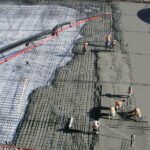إجهاد الخرسانة:
أنواع الإجهاد في الخرسانة :
إجهاد الضغط:
إجهاد الشد:
إجهاد الانحناء:
اجهاد التماسك:
- رتبة الخرسانة: والتي يتم التعبير عنها باجهاد الضغط للخرسانة.
- نوع الحديد: والتي يعبر عنها برتبة الحديد وحالة السطح هل هي مشرشرة ام ملساء.
- مكونات الخلطة وطرق الصب: وهي حالة الخرسانة بعد الصب هل يوجد تعشيش او شروخ في الخرسانة ام لا.
أسباب حدوث الإجهاد في الخرسانة :
- الأحمال الحية : مثل وزن الأشخاص والأثاث والمعدات.
- الأحمال الميتة : مثل وزن البناء نفسه.
- التغيرات في درجة الحرارة : تتسبب التغيرات في درجة الحرارة في تمدد أو انكماش الخرسانة، مما يؤدي إلى حدوث إجهادات.
- الانكماش : يحدث انكماش في الخرسانة بعد الصب بسبب فقدان الماء، مما يؤدي إلى حدوث إجهادات داخلية.
أهمية دراسة إجهاد الخرسانة :
- تصميم هياكل خرسانية آمنة : يساعد فهم إجهاد الخرسانة المهندسين على تصميم هياكل قادرة على تحمل الأحمال المختلفة دون فشل.
- تجنب حدوث التشققات : يمكن للتشققات أن تضعف هيكل الخرسانة وتؤثر على متانته.
- زيادة عمر الخدمة للهيكل : يمكن تصميم الهياكل لتتحمل الإجهادات على المدى الطويل، مما يزيد من عمرها الافتراضي.
Concrete strength:
Concrete strength is the internal force that resists external loads acting on a concrete element. In other words, it is the tension or pressure to which concrete is exposed as a result of various loads, whether they are fixed loads such as the weight of the building itself, or variable loads such as live loads resulting from the use of the building.
Types of concrete strength:
Compressive strength:
It is the strength that concrete is designed for, as concrete can withstand compressive forces and cannot withstand tensile or bending forces, and therefore the resistance that concrete is designed for is pressure resistance. The compressive stress of ordinary concrete ranges from 150 kg/cm2 to 200 kg/cm2, while reinforced concrete ranges from 200 kg/cm2 to 500 kg/cm2.
Tensile strength:
It occurs when external forces pull parts of concrete apart. Concrete is very weak in tensile resistance, so concrete is usually strengthened with rebar to withstand these types of stresses, as the concrete stress in tension is approximately 10% of the compressive stress.
Bending strength:
It is a combination of tension and compression, and usually occurs in long, thin concrete elements such as balls and columns that are subject to bending moments.
Cohesion stress:
- It is the bond between the iron bars and the concrete itself, and it depends on several factors, the most important of which are the following:
- Concrete grade: which is expressed by the compressive stress of concrete.
- Type of steel bars: which is expressed by the grade of iron and the condition of the surface, whether it is serrated or plain.
- Components of the mixture and pouring methods: This is the condition of the concrete after pouring, whether there are nests or cracks in the concrete or not.
Causes of stress in concrete:
- Live loads: such as the weight of people, furniture and equipment.
- Dead loads: such as the weight of the building itself.
- Temperature changes: Temperature changes cause concrete to expand or contract, resulting in stresses.
- Shrinkage: Shrinkage occurs in concrete after pouring due to water loss, which leads to internal stresses.
The importance of studying concrete stress:
- Designing safe concrete structures: Understanding concrete stress helps engineers design structures capable of withstanding various loads without failure.
- Avoid cracks: Cracks can weaken the concrete structure and affect its durability.
- Increased service life of the structure: Structures can be designed to withstand long-term stresses, increasing their lifespan.



